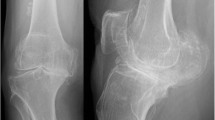Abstract
High tibial osteotomy (HTO) is used as an alternative to total knee arthroplasty in young patients with knee osteoarthritis. In the conventional HTO, if the distraction distance is large, the osteotomy section will be significantly separated, forming a large bone defect gap, which may lead to delayed healing or even nonunion. We treated a series of 10 patients with medial knee osteoarthritis by a novel M-shaped high tibial osteotomy. This helped to improve greater contact of cortical sections and rapid healing of the osteotomy break. Over a mean follow-up period of 8.5 months (range, 6.0–12.0 months), all patients achieved bone union. None of the patients showed complications such as nonunion or infection. The novel M-shaped HTO procedure can reduce the probability of delayed union/nonunion and avoid the complications associated with bone grafting. Hence, this technique may be an effective alternative for the HTO.



Similar content being viewed by others
References
Jackson, J. P. (1958). Osteotomy for osteoarthritis of the knee. In proceedings of the Sheffield regional orthopaedic club. The Journal of Bone and Joint Surgery, 40, 826.
Gama, D. F., Cabral, J., Vale, M., Freitas, R. T., & Varatojo, R. (2019). Dome-shaped osteotomy for revision of failed closing-wedge high tibial osteotomy orthopaedic. Journal of Sports Medicine, 7(7), 2325967119857047.
Presutti, M., Goderecci, R., Palumbo, P., Giannetti, A., Mazzoleni, M. G., Randelli, F. M. N., Angelozzi, M., Calvisi, V., & Fidanza, A. (2021). A novel biplanar medial opening-wedge high tibial osteotomy: The Z-shaped technique. A case series at 72 years follow-up. Journal of Orthopaedics and Traumatology, 22(1), 53.
Wang, Z., Zeng, Y., She, W., Luo, X., & Cai, L. (2018). Is opening-wedge high tibial osteotomy superior to closing-wedge high tibial osteotomy in treatment of unicompartmental osteoarthritis? A meta-analysis of randomized controlled trials. International Journal of Surgery, 60, 153–163.
Atrey, A., Morison, Z., Tosounidis, T., Tunggal, J., & Waddell, J. P. (2012). Complications of closing wedge high tibial osteotomies for unicompartmental osteoarthritis of the knee. Bone Joint Res, 1(9), 205–209.
Sundaram, N. A., Hallett, J. P., & Sullivan, M. F. (2020). Dome osteotomy of the tibia for osteoarthritis of the knee. The Journal of Bone and Joint Surgery, 38(1), 83–86.
Martin, R., Birmingham, T. B., Willits, K., Litchfield, R., Lebel, M. E., & Giffin, J. R. (2014). Adverse event rates and classifications in medial opening wedge high tibial osteotomy. American Journal of Sports Medicine, 42(5), 1118–1126.
Aryee, S., Imhoff, A. B., Rose, T., & Tischer, T. (2008). Do we need synthetic osteotomy augmentation materials for opening-wedge high tibial osteotomy. Biomaterials, 29(26), 3497–3502.
El-Assal, M. A., Khalifa, Y. E., Abdel-Hamid, M. M., Said, H. G., & Bakr, H. M. (2010). Opening-wedge high tibial osteotomy without bone graft. Knee Surgery, Sports Traumatology, Arthroscopy, 18(7), 961–966.
Slevin, O., Ayeni, O. R., Hinterwimmer, S., Tischer, T., Feucht, M. J., & Hirschmann, M. T. (2016). The role of bone void fillers in medial opening wedge high tibial osteotomy: A systematic review. Knee Surgery, Sports Traumatology, Arthroscopy, 24(11), 3584–3598.
Acknowledgements
We thank the whole team for their selfless dedication.
Funding
No funds, grants, or other support was received.
Author information
Authors and Affiliations
Contributions
DL: Performed the methodology, Wrote the original draft of the manuscript. HL: Investigation and Wrote, Reviewed and edited the manuscript. YL: Reviewed and edited the manuscript. GZ: Curated the data. WL: Curated the data. XY: Performed the visualization. JT: Carried out the project administration.
Corresponding author
Ethics declarations
Conflict of Interest
All authors certify that they have no affiliations with or involvement in any organization or entity with any financial interest or non-financial interest in the subject matter or materials discussed in this manuscript.
Ethical Approval
This retrospective study has been approved by the ethical committee of the Affiliated People’s Hospital of Jiangsu university.
Consent to Participate
Informed consent was obtained from all individual participants included in the study.
Consent for Publication
Not applicable.
Data availability
Data supporting the study is available upon reasonable request from the authors.
Additional information
Publisher's Note
Springer Nature remains neutral with regard to jurisdictional claims in published maps and institutional affiliations.
Rights and permissions
Springer Nature or its licensor (e.g. a society or other partner) holds exclusive rights to this article under a publishing agreement with the author(s) or other rightsholder(s); author self-archiving of the accepted manuscript version of this article is solely governed by the terms of such publishing agreement and applicable law.
About this article
Cite this article
Liu, D., Liu, H., Li, Y. et al. Application of a New M-shaped High Tibial Osteotomy Method: A Technical Note. JOIO 57, 1153–1157 (2023). https://doi.org/10.1007/s43465-023-00904-8
Received:
Accepted:
Published:
Issue Date:
DOI: https://doi.org/10.1007/s43465-023-00904-8




